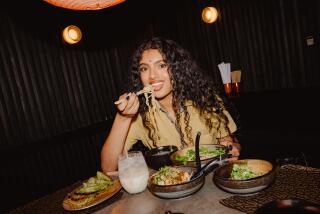RESTAURANTS : Dewi Is Casual but Exotic
Edith Gilhuys is a handsome, statuesque woman who looks as if her ancestors could be from practically anywhere. And in a way, they are: Dutch and Javanese on her mother’s side, Spanish and French on her father’s. Her husband, with whom she runs Dewi Restaurant in Huntington Beach, boasts of equally exotic bloodlines.
“We Dutch Indonesians are all mixed up,” she says wryly. Well, pleasantly mixed, let’s say--and we might say the same for her native cuisine.
Indonesia is an archipelago encompassing hundreds of islands--and their cultures and cooking styles. What passes for Indonesian cuisine in this country is really a Malay-influenced style of cooking with roots in central Java. The vastly different foods of, say, the islands of Sumatra, Sulawesi and Bali are barely available on these shores.
The food you’ll eat at Dewi is typical of what you get at most Indonesian restaurants in this country--the good home cooking of Java. Chuck Gilhuys is from Jakarta, Indonesia’s capital; Edith is from Semarang in central Java. Like most Asian cuisines, Java’s is based on rice, and like most equatorial cooking, it can be blistering hot.
Come casual to this restaurant. The ambience is simple and even a bit downscale. The only decoration is a corkboard wall with a few batiks and pictures of tropical fruits stuck to it; the seating is basic, almost Spartan.
One corner of the cafe is a sort of mini-market where Dutch and Indonesian foodstuffs are sold. You’ll find items such as lengkuas, otherwise known as galangal or laos root; daun salam, a relative of the bay leaf; sambal badjak, ground red-pepper paste with onion in a jar with an air of foreboding; various types of fish and prawn crackers ready to be puffed up in hot oil; blocks of dried shrimp paste, which is an acquired taste but a substance essential to this cuisine.
The rest is restaurant. Work your way up to the really unusual dishes here by ordering a tableful of Dutch-Indonesian snacks, many of which are sold on street corners in the Netherlands. The croquettes are soft deep-fried cylinders of ground beef. Sauzijze brood (say sow’s-EYES-yeh BRODE) are puff pastry triangles filled with a mildly spiced meat mixture flavored with curry. Lumpia are Indonesian egg rolls, larger and meatier than their Chinese cousins, rounded out nicely by minced cabbage and bamboo shoots.
These snacks are all delicious, but they’re a bit on the oily side. I actually prefer two snacks that are pure Indonesian. One is lemper , tiny cold rice rolls stuffed with a sweet-hot ground chicken filling. They come wrapped in aluminum foil and are, not surprisingly, often the first thing to sell out here.
The bags of squiggly, alien-looking disks on the front counter are balembang, Sumatran fish crackers. Unlike the insipid kerupuk (shrimp chips) served in rainbow colors at many Chinese restaurants, these crackers have real flavor. They are also based on tapioca flour, but they taste strongly of the sea, and I find them more addictive than good potato chips.
Now, on to more substantial things. The most popular dish here, and at any Indonesian restaurant in the West, has to be satay, skewers of diced meat grilled on a charcoal brazier. These satay come in two varieties, chicken and pork.
The chicken satay is the sweeter, and it goes well with the unctuous deep-brown peanut dipping sauce served on the side. The pork makes a more interesting choice when eaten with Edith Gilhuys’ sambal, a fire-engine-red chili sauce. The three-alarm version, which has a flavor to match the fiery color, is available on request--and believe me, you won’t need much.
Dewi does not serve rijsttaffel, the traditional Indonesian “rice table” that can contain as many as 30 different dishes (not counting the rice), but a mixed-rice plate called nasi rames is a good short course in this cuisine. It’s a mound of white rice with sambal goreng telor (chili spiced egg), empal pedes (hot spiced meat), rendang (cubed beef cooked in coconut milk, ginger and chili) and barbecued chicken.
Nasi goreng, the Indonesian fried rice, makes an even heartier meal here, especially eaten with the Indonesian salad gado-gado. The former is a mountainous plate of rice stir-fried with chili, egg, chicken, pork and various spices. It’ll be a deep brown by the time it arrives at your table. Gado-gado is a big melange of tofu, bean sprouts, salad greens and lots of that thick peanut sauce. Healthful this might be; low-cal it ain’t.
You’ll find a few other dishes on this menu, side dishes mostly, intended for white rice. Sayur lodeh is cabbage, carrot, onion and green beans, cooked in coconut milk. Ketoprak is a tofu dish with eggs and kecap manis, a sweet, sticky soy sauce that takes a little getting used to.
I’d like to see this food become more popular, but I understand why it hasn’t so far. The restaurant is on a sleepy, out-of-the-way corner (Hamilton Avenue and Bushard Street), and it keeps odd hours (opening at 3 p.m. most days). Still, if you’re looking for something exotic and simple, look no further than Dewi.
Dewi is remarkably inexpensive. Snacks are 90 cents to $1.25. Side dishes are $2.85 to $7.25. Dinners are $3.25 to $5.95.
* DEWI
* 9606 Hamilton Ave., Huntington Beach.
* (714) 962-4446.
* Dinner Tuesday through Friday, 3 to 9 p.m.; Lunch and dinner Saturday, 1 to 9 p.m., and Sunday, noon to 6 p.m.
* Cash only.
More to Read
Eat your way across L.A.
Get our weekly Tasting Notes newsletter for reviews, news and more.
You may occasionally receive promotional content from the Los Angeles Times.









